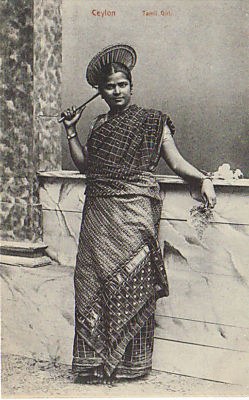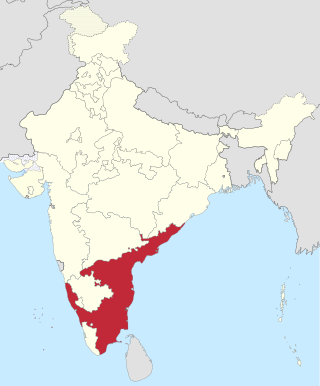
The Tamil people, also known as Tamilar, Tamilians, or simply Tamils, are an ethnolinguistic group who natively speak the Tamil language and trace their ancestry mainly to India's southern state of Tamil Nadu, to the union territory of Puducherry, and to Sri Lanka. The Tamil language is one of the world's longest-surviving classical languages, with over 2000 years of Tamil literature, including the Sangam poems, which were composed between 300 BCE and 300 CE. People who speak Tamil as their mother tongue and are born in Tamil clans are considered Tamils.

The history of southern India covers a span of over four thousand years during which the region saw the rise and fall of a number of dynasties and empires.

The Pandyan dynasty, also referred to as the Pandyas of Madurai, was an ancient Tamil dynasty of South India, and among the four great kingdoms of Tamilakam, the other three being the Pallavas, the Cholas and the Cheras. Existing since at least the 4th to 3rd centuries BCE, the dynasty passed through two periods of imperial dominance, the 6th to 10th centuries CE, and under the 'Later Pandyas'. Under Jatavarman Sundara Pandyan I and Maravarman Kulasekara Pandyan I, the Pandyas ruled extensive territories including regions of present-day South India and northern Sri Lanka through vassal states subject to Madurai.

Kulottunga I also spelt Kulothunga, born Rajendra Chalukya, was a Chola Emperor who reigned from 1070 to 1122 succeeding his cousin Athirajendra Chola. He also served as the Eastern Chalukya monarch from 1061 to 1118, succeeding his father Rajaraja Narendra. He is related to the Chola dynasty through his mother's side and the Eastern Chalukyas through his father's side. His mother, Ammangaidevi, was a Chola princess and the daughter of emperor Rajendra I. His father was king Rajaraja Narendra of the Eastern Chalukya dynasty who was the nephew of Rajendra and maternal grandson of Rajaraja I. According to historian Sailendra Nath Sen, his accession marked the beginning of a new era and ushered in a period of internal peace and benevolent administration.

Kongu Nadu, also known as Kongu Mandalam, is a geographical region comprising the western part of the Indian state of Tamil Nadu and parts of southeastern Karnataka and eastern Kerala. The region covers an area of roughly 60,895 km2 (23,512 sq mi) with a population of over 27.4 million.

Pandya Nadu or Pandi Nadu is a geographical region comprising the southern part of the present day state of Tamil Nadu. The region is bounded on its West by the Venad/Ay Nadu, Northeast by the Chola Nadu and Northwest by the Kongu Nadu. It comprises the present-day districts of Madurai, Theni, Sivaganga, Ramanathapuram, Virudhunagar, Tirunelveli, Tenkasi, Thoothukudi, Kanniyakumari, parts of Pudukkottai and Dindigul.

The Chera dynasty, was a Sangam age Tamil dynasty who unified various regions of the western coast and western ghats in southern India to form the early Chera empire. The dynasty, known as one of the Three Crowned Kings of Tamilakam alongside the Chola and Pandya, has been documented as early as the 4th to 3rd centuries BCE. Their governance extended over diverse territories until the 12th century CE.

Sri Lankan Tamils, also known as Ceylon Tamils or Eelam Tamils, are Tamils native to the South Asian island state of Sri Lanka. Today, they constitute a majority in the Northern Province, form the plurality in the Eastern Province and are in the minority throughout the rest of the country. 70% of Sri Lankan Tamils in Sri Lanka live in the Northern and Eastern provinces.

The Sangam period or age, particularly referring to the third Sangam period, is the period of the history of ancient Tamil Nadu and Kerala, and parts of Sri Lanka dating back to c.6th century BCE. It was named after the legendary Sangam academies of poets and scholars centered in the city of Madurai which are believed to be mythical.

Tamilakam was the geographical region inhabited by the ancient Tamil people, covering the southernmost region of the Indian subcontinent. Tamilakam covered today's Tamil Nadu, Kerala, Puducherry, Lakshadweep and southern parts of Andhra Pradesh and Karnataka. Traditional accounts and the Tolkāppiyam referred to these territories as a single cultural area, where Tamil was the natural language and permeated the culture of all its inhabitants. The ancient Tamil country was divided into kingdoms. The best known among them were the Cheras, Cholas, Pandyans and Pallavas. During the Sangam period, Tamil culture began to spread outside Tamilakam. Ancient Tamil settlements were also established in Sri Lanka and the Maldives (Giravarus), prior to the migration of Prakrit speakers.

Mushika dynasty, also spelled Mushaka, was a minor dynastic power that held sway over the region in and around Mount Ezhi (Ezhimala) in present-day North Malabar, Kerala, India. The country of the Mushikas, ruled by an ancient lineage of the Hehaya clan of the same name, appears in early historic (pre-Pallava) south India and it is believed that Mushika dynasty has their descents from Heheya Kingdom. Early Tamil poems contain several references to the exploits of Nannan of Ezhimalai. Nannan was known as a great enemy of the pre-Pallava Chera chieftains. The clan also had matrimonial alliances with the Chera, Pandya and Chola chieftains. The Kolathunadu (Kannur) Kingdom, which was the descendant of Mushika dynasty, at the peak of its power, reportedly extended from Netravati River (Mangalore) in the north to Korapuzha (Kozhikode) in the south with Arabian Sea on the west and Kodagu hills on the eastern boundary, also including the isolated islands of Lakshadweep in the Arabian Sea.

The region of Tamil Nadu in the southeast of modern India, shows evidence of having had continuous human habitation from 15,000 BCE to 10,000 BCE. Throughout its history, spanning the early Upper Paleolithic age to modern times, this region has coexisted with various external cultures.

Nainativu, is a small but notable island off the coast of Jaffna Peninsula in the Northern Province, Sri Lanka. The name of the island alludes to the folklore inhabitants, the Naga people. It is home to the Hindu shrine of Nagapooshani Amman Temple; one of the prominent 64 Shakti Peethas, and the Buddhist shrine Nagadeepa Purana Viharaya.

The Rowther are originally a Tamil community from the Indian state of Tamil Nadu and Kerala. they were converted to Islam by the preacher Nathar Shah. Even after conversion they retained their caste name. they were elite cavalrymen of the Chola and Pandya kingdoms. They were traditionally a martial clan like the Maravars, and constitute large part of the multi-ethnic Tamil Muslim community. Rowthers have also been found as Tamil polygars, zamindars and chieftains from the 16th to 18th centuries. The traditional homelands of the Rowthers were in the interior of Southern Tamilakam.

Atiyamāṉ were a royal Velir dynasty. These king-chiefs ruled from their capital Tagadur from at least the 3rd century BCE. The royal house was one of the four kingdoms of Tamilakam, ruling parts of the Kongu Nadu. They were surrounded by the Cheras to the west and the Pandyas and Cholas to the east.

Madras State was a state of India which was in existence during the mid-20th century. The state came into existence on 26 January 1950 when the Constitution of India was adopted and included the present-day Tamil Nadu, Kerala and parts of neighboring states of Andhra Pradesh and Karnataka. Andhra state was separated in 1953 and the state was further re-organized when states were redrawn linguistically in 1956. On 14 January 1969, the state was renamed as Tamil Nadu.

The Three Crowned rulers, or the Three Glorified by Heaven, or World of the Three or The Tamil Kings, primarily known as Muvendar, refers to the triumvirate of Chera, Chola and Pandya who dominated the politics of the ancient Tamil country, Tamilakam, from their three Nadu (countries) of Chola Nadu, Pandya Nadu and Chera Nadu in southern India. They signalled a time of integration and political identity for the Tamil people. They frequently waged war against one another under a period of instability and between each other, held control over Greater Tamilakam from 6th century BCE to the 13th century. After being defeated by the Pandyas, the Cholas fled to Devicottah and are later mentioned in various texts that participated in wars in the 16th century.
When to date the start of the history of the Jaffna kingdom is debated among historians.
Mukkuvar is a maritime ethnic group found in the Indian states of Kerala, Tamil Nadu and the Eastern and North Western coastal regions of Sri Lanka. They are mostly found on the Malabar Coast, South Travancore Coast and Kanyakumari district, Tamil Nadu, who have traditionally been involved in fishing and other maritime activities.

Tamil dynasties are the kingdoms who ruled over present day Tamil Nadu, Sri Lanka, Andhra Pradesh, Karnataka, Kerala and Odisha. These include the Pallavas, the Pandyas, the Cholas and the Cheras.















